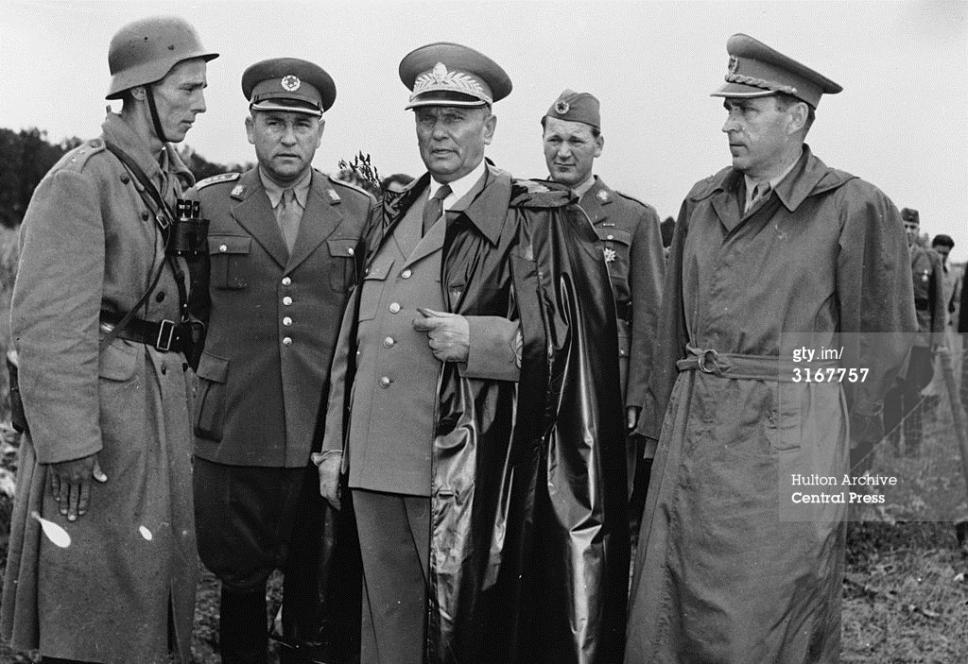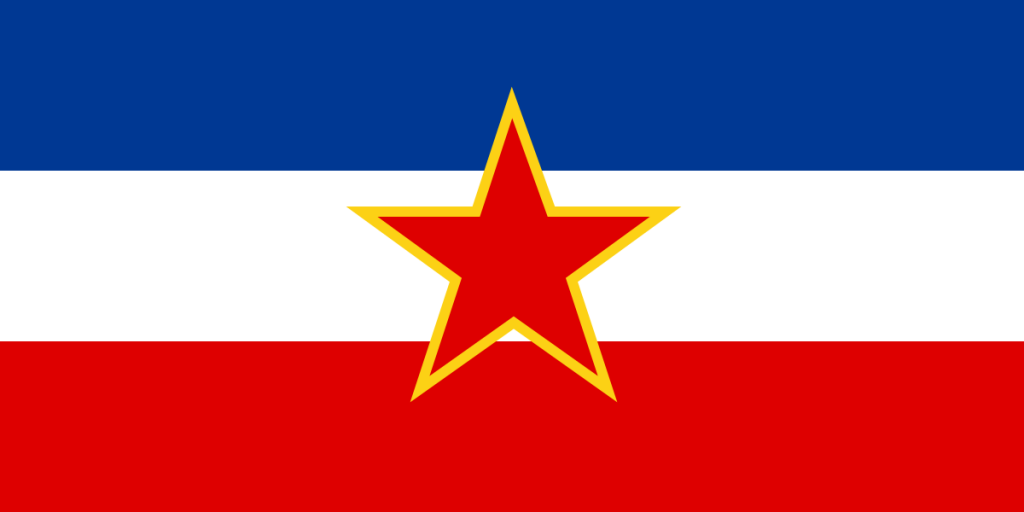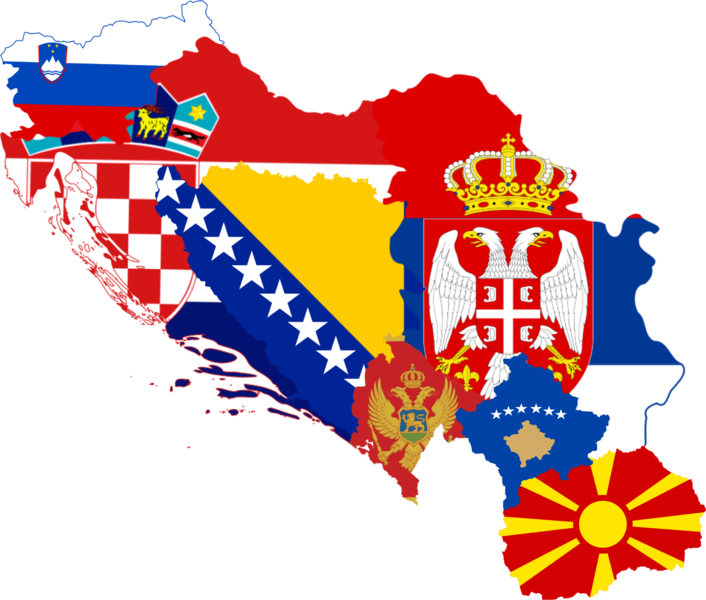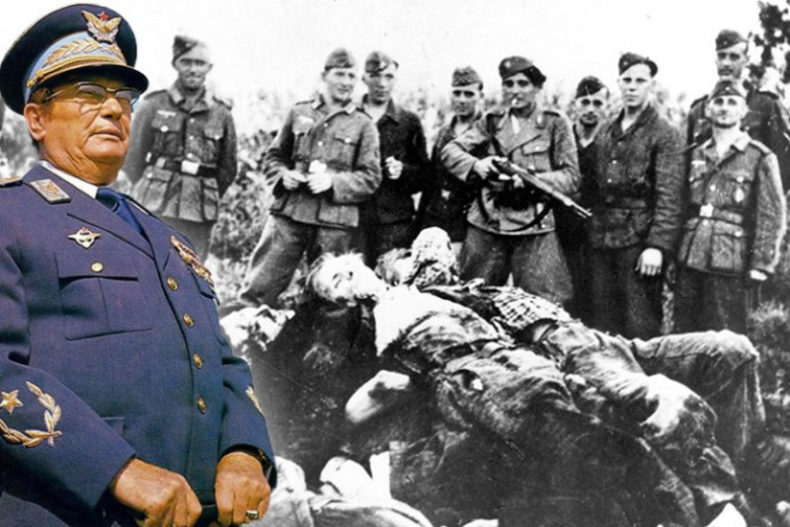
Views: 983
After WWII, the official state-sponsored myth, based on notorious lies and forged historical facts, of the anti-fascist combat and the liberation of Yugoslavia by Tito’s Partisans acquired a political life of its own until the 1990s.

The official brainwashed dogma became the so-called National Liberation of Yugoslavia while the personal cult of Josip Broz Tito became framed on the propaganda that self-proclaimed “Marshall” of Yugoslavia (on November 29th, 1943 in Bosnian town of Jajce) was one of the most intelligent and ingenious national leaders of the anti-fascist coalition in Europe during the wartime.[i] However, in post-1945 Socialist Federal Republic of Yugoslavia (the SFRY) this myth, in fact, served as the focal political and moral instrument of legitimation of illegitimate and unchallenged rule of the Communist Party of Yugoslavia (the CPY, since 1963 the Union of the Communists of Yugoslavia) over Yugoslavia. According to the myth, this, in essence, banditry party was the “liberator” of the country from the foreign occupants and their domestic satellites and only this party deserved and was able after the war to provide continuous protection from different foreign enemies still threatened Yugoslavia either from the East (the USSR) or the West (the Western imperialists).
The Communist dictatorship was formally legalized by the first post-war Constitution (January 31st, 1946) which abolished the monarchy and proclaimed the Federal People’s Republic of Yugoslavia. This first Titoist Constitution was based on the 1936 Soviet (Stalinist) Constitution.[ii] A Yugoslav “people’s” (Socialist) republic was the first one in the series of similar people’s republics formed in East-Central and South-East Europe after 1945 based on the Marxist ideology and both the Soviet example and under the Soviet control. Based on its revolutionary ideology, the victorious CPY intended to create a new state and a new society which would have no relations to the former capitalist and parliamentary the Kingdom of Yugoslavia except in the name.
All kinds of Yugoslavia were ideologically founded on myths:
- The interwar Yugoslavia developed a myth of the „three ethnic tribes of the same ethnic nation“ as it was assumed that the Slovenes, the Croats, and the Serbs have been of the same ethnolinguistic origin sharing the same or very similar (Yugoslav) cultural, custom, linguistic and tradition features and having the same historical destiny to struggle for the national (Yugoslav) unification what was finally realized on December 1st, 1918.[iii]
- A New Socialist Yugoslavia, from an ideological point of view, was re-established on another myth: a myth of self-determination of its five recognized constituent ethnic nations−the Slovenes, the Croats, the Serbs, the Montenegrins, and the Macedonians. These five nations (originally without later on recognized Bosnian-Herzegovinian Muslims[iv]) allegedly performed at the Second Meeting of the Communist-dominated National Liberation Council of Yugoslavia (the NLCY), on November 29th‒30th, 1943 in Jajce (in mid-Bosnia-Herzegovina) when a new Yugoslavia was declaratively proclaimed. According to this myth, the legal representatives of the five nations, irrespective of the Federal republic in which they lived in Yugoslavia, exercised once and for all their right to national self-determination by uniting in the federation of six republics finally established in January 1946. Therefore, the Jajce meeting in 1943 was allegedly a legitimate one as the formal representatives of all five constituent nations attended it regardless to the very fact that the representatives of Serbia were missing (they were replaced by the Serbs from other parts of Yugoslavia).
The national question influenced every aspect of Yugoslavia’s inner politics after the unification in 1918. It was reflected in the internal, external, social, cultural, economic and other affairs. It was tried to be solved by democrats, autocrats, kings, and Communists.[v] The Communists, however, became extremely proud to formally announce that they finally succeeded to solve all national questions in Yugoslavia after 1945 by the creation of six republics as the national “states” followed by two autonomous units within Serbia (the Vojvodina province and the Kosovo-Metochia region, later on with a changed name upgraded to a provincial status). In fact, these two autonomous units gradually have been separated from the rest of Serbia and finally, according to the last (third) Yugoslav Constitution of 1974, both of them received the same and equal political power as all republics with their own Presidency, Governments, education programs, security forces, Constitutions, Academies, insignias, and even the veto rights in the Federal Government.
However, with regard to the Communist claim that they solved national questions in Yugoslavia, as the most problematic historical and political issue of the country, one can raise two questions:
- Why the autonomous units were created only within Serbia but not within other Yugoslav republics as well?
- On which background the boundaries between republics and of autonomous units were established?
In regard to the first question, the fact is that in all Yugoslav republics could be formed autonomous units (regions or provinces) based on ethnic and historical backgrounds as it was done within Serbia. However, for instance, Kosovo-Metochia’s Albanians were granted with an autonomous status in Serbia but the Serbs in Croatia or Bosnia-Herzegovina did not deserve, for some reason, the same treatment by the same central authority. Moreover, the focal anomaly of this issue was that the same ethnic Albanians living in compact masses in North-West Macedonia did not enjoy the same national-political status in their republic like their compatriots in neighboring Serbia. The real reason for such a national policy of asymmetry was, in fact, a general policy of the CPY framed within the slogan: “Weaker Serbia, Stronger Yugoslavia”.
What concerns the second question, the focal fact is that, basically, nobody really knows who, how and on which historical, ethnic, moral, economic or so foundations or criteria the interrepublican and interrepublican-provincial boundaries are fixed in 1946. However, the same boundaries became the borders of (up today) seven internationally recognized independent states after the destruction of Titoslavia in the 1990s.[vi] In other words, simply there is no single real legal act, i.e. document, which regulates the boundary issue of the Yugoslav six republics and two autonomous units. In fact, there is one document in relations to this issue: a report with the proposal of the Commission accepted by the Central Committee of the CPY[vii] but, however, no single state’s institution or some public discussion did not elaborate or accepted it. Moreover, de facto, administrative-territorial delimitation within Yugoslavia was accomplished only partially according to the mentioned report and proposal.[viii] Anyway, in order to settle national questions according to the Communist principles, Tito adopted the Soviet model of establishing republics as national states that had to be “national in form, socialist in content”.[ix] The Montenegrins and the Macedonians for the first time in history received the recognition as distinctive (artificial) ethnic nations (separated from the Serbs) and, therefore, a right to their separate national state (republic). Finally, a sixth republic was created (Bosnia-Herzegovina) for the mixed Serb, Croat, and Muslim (today Bosniak) population.
A total political power in the country, once again founded on the Soviet example, was absolutely concentrated in the highly centralized CPY especially in its Politburo of the Central Committee, whose members were chosen by the CPY’s General Secretary Josip Broz Tito who, basically, transformed the whole country into his own private feud – Titoslavia. Originally, he was appointed as a Party’s General Secretary by Stalin’s International in Moscow in 1937 and Tito since that time had filled the top CPY’s positions only with those members who were personally loyal to him.[x] Practically, since June 28th, 1948 till his death on May 4th, 1980 Josip Broz Tito had no serious political rival within the CPY or in the country as he was undisputed leader of the Party and unchallenged and merciless dictator of the country governing it by hand-picked marionettes but the top positions in both the Party and the country were mainly reserved for non-Serbs.[xi] Tito became a popular figure in Yugoslavia from mid-1948 when he and his CPY were expelled from the Cominform (the Communist Information Bureau located in Moscow) as the Western agents as to Stalin’s impotent anger, Tito accepted US’s aid in 1948.[xii] However, the Titoist propaganda promulgated a false idea that it was, in fact, a great Yugoslav victory as Tito allegedly defeated Stalin and the Soviet Union by pioneering an ideology of an independent national Communism from Moscow.[xiii] However, it is true that from mid-1948 Yugoslavia pursued an independent policy from Moscow but at turn became a client state of Washington. Tito played off, anyway, very successfully US for the Soviet support: a game in which he excelled becoming a master of diplomatic gangsterism during the Cold War.[xiv]
A Yugoslav dictator managed to repress conflicting ethnic identities and nationalisms by imposing total political control over the country and its political life followed by a personal dictatorship. Nevertheless, it was quite predictable and expected that after his death in 1980, ethnonational tensions and conflicts within the country are going to resurface. Slovenia and Croatia became the first separatist republics in 1991 but on another hand both of them were territorially enlarged after WWII only due to Tito’s support who included nearly 8,330 sq km of former Italian territory on the Istrian peninsula and adjacent to the city of Trieste – a territory divided by Slovenia and Croatia within Titoslavia. That was basically the Anglo-American gift to him according to the 1954 Belgrade Agreement for his split with Stalin in 1948.[xv]
Actually, with historical bitterness and hatred between Yugoslavia’s some twenty different nationalities and ethnic groups at all-time high, especially during WWII, another attempt of unification and coexistence of the Yugoslavs could be possible only by an iron will and dictatorship that was imposed by Josip Broz Tito.[xvi] The differences between all Yugoslav ethnic, confessional, regional, and nationalities’ groups, which had been extremely intensified during WWII, however, were never properly and deeply addressed or publicly discussed, and were, in fact, largely suppressed, particularly the issue of the Croat-Bosniak-run genocide over the Serbs in the Independent State of Croatia and ethnic cleansing of Kosovo-Metochia by the Albanian Nazi-fascist nationalists.
Following its Soviet model, Titoslavia was till 1974 Constitution a centralized one-party political system with a federation based on the mythical self-determination of its nations but not of the republics or autonomous units. The boundaries between the Federal units until 1974 have not been of significant practical and political importance. Regardless of the fact that there was no official explanation of how the boundaries between the republics and autonomous units were fixed in 1946, most of them followed the pre-WWI international and internal Austro-Hungarian provincial borders. That is true especially concerning Bosnia-Hercegovina’s boundaries and between Serbia and Croatia. In other words, the boundaries between Bosnia-Herzegovina and Croatia essentially with some minor corrections followed the border between the Ottoman Sultanate and the Austro-Hungarian Empire fixed in 1699 after the Great Vienna War according to the Peace Treaty of Karlowitz (today Sremski Karlovci in Serbia’s province of Vojvodina).[xvii] In 1908 with the Austro-Hungarian annexation of Bosnia-Herzegovina the border became a provincial boundary within the Dual Monarchy. However, it became rather ironic that the revolutionary CPY, intent on establishing a new state and new society, chose in 1946 to use the borders of the two empires which were ruling the Yugoslavs for the centuries and finally became disintegrated as the result of WWI.
The focal point of the fixing boundaries of the Yugoslav republics was that almost no one of them coincided with the boundaries between the ethnonational groups as, for instance, a huge number of the Serbs were left in Croatia (12%) and Bosnia-Herzegovina (33%) while the Albanians and the Croats were living in three republics. The most ethnically homogeneous republic was Slovenia while Bosnia-Herzegovina was the most heterogeneous.[xviii] As a consequence of respecting the pre-WWI internal boundaries of the multinational and multiconfessional Dual Monarchy, since 1946 onward at least 30 per cent of the Serbs and 20 per cent of the Croats were left outside of their “national” republics, Serbia and Croatia. A majority of a diaspora of both of them within Yugoslavia was and still is living in the central Yugoslav republic (today independent state) of Bosnia-Herzegovina. But the crucial point of such inner administrative division of Titoslavia was a fact that the new post-WWII Federal structure of the country with its new/old boundaries (today the borders of independent states) ensured that the largest and most dispersed nation in the country (the Serbs) would not be given a republic large enough to enable a Serb domination of Titoslavia.[xix] In other words, everything was done that the others would administer the Serbs who became the only oppressed nation in the country of Titoslavia – The Prison of the Serbs.
That Serbia did not have equal status with other republics was quite visible from the fact that only Serbia had an autonomous province and an autonomous region. The other republics did not deserve such “privilege”. Such obvious discrimination of the Serbs as a nation and especially Serbia as a republic was wrapped into the formal principle of equality of all nations which in a one-party dictatorship served largely symbolic and propaganda purposes. Formally, such principle dictated that no nation, a Serbian or otherwise, could dominate the rest of the country in any way but the reality was quite different, especially if we know that the dictator himself was a notorious Serbophobe, even since the WWI, being of the Roman Catholic Slovene-Croat origin.[xx] Nevertheless, as the Communist (or quasi-Communist) authorities did not allow any public dissent on any political issue, for the researchers is very difficult to estimate the real extent of the support for the new Federal structure and for the regime’s policy of alleged national equality after 1946.
Regardless of the fact that the Titoist regime was able to suppress all rival national political movements until 1981, the policy of national equality, however, facilitated the revival of some of the previous national ideologies and the construction of new ones by the Communist elite which was gradually sinking deeply into the republican nationalisms for the sake to expand constituencies and consolidation of their political power especially after Tito’s death in 1980. It has to be noticed that the cadre constituencies became the chief beneficiaries of the Titoist regime and its focal pillar of support. But, on another hand, they as well as established a power-base for the future republican elites in all six republics in the 1960s running with policies of republican nationalisms which finally transformed the country according to the last Constitution of 1974 into, de facto, a semi-confederation of six republics and two autonomous provinces. Such political arrangement was possible by assigning to each republic and province extremely wide a range of sovereign (independent) rights and powers that they became both the sources of state’s sovereignty and centers of political power.
The essence of such arrangement was that since the most important state’s decision-making organs (the collective Presidency and the Federal Government), were controlled since 1974 by the political leaders of the republics and the provinces, there was no, in fact, a real Federal organ to be independent of republican control, which could override their authority or even arbitrate in any conflicts among them. Tito’s unquestioned supremacy was based on the personal loyalty of the cadres and on his undisputed command of the Yugoslav People’s Army (the YPA). However, after his death in 1980, the institution of the President of Yugoslavia was simply abolished, and, therefore, the republican and the provincial ruling elites have been thus totally left to impose undisputed control over their respected administrative units which in the 1990s became independent states as their boundaries were internationally recognized as the borders.
sotirovic1967@gmail.com
© Vladislav B. Sotirović 2019
ENDNOTES:
[i] See one of the most typical books of whitewashed Tito’s official biography for the sake of maintaining his personal cult [Branislav Ilić, Vojislav Ćirković (priredili), Hronologija revolucionarne delatnosti Josipa Broza Tita, Beograd: Export-Press, 1978]. Compare with more objective and academic Tito’s biography in [Jože Pirjevec, Tito i drugovi, I−II, Beograd: Laguna, 2013].
[ii] Branko Petranović, Istorija Jugoslavije 1918−1988. Treća knjiga: Socijalistička Jugoslavija 1945−1988, Beograd: NOLIT, 1988, 67.
[iii] See, for instance [Владимир Ћоровић, Историја Југославије, Београд: Народно дело, 1933].
[iv] This term did not refer to the Muslim Albanians or any other Islamic groups but only to the Slavophone Muslims from Bosnia-Herzegovina.
[v] Ivo Banac, The National Question in Yugoslavia: Origins, History, Politics, Ithaca−London: Cornell University Press, 1984, 415−416.
[vi] On the issue about contested territories between the Serbs and the Croats, see in [Лазо М. Костић, Спорне територије Срба и Хрвата, Београд: Дерета, 1990].
[vii] Archives of Yugoslavia, Folder CK SKJ X-2/1 and III/3; Archives of Memorial Centre “Josip Broz Tito”, II-5-b/66.
[viii] Миодраг Зечевић, Југославија 1918−1992: Јужнословенски државни сан и јава, Београд: Просвета, 1994, 127−128.
[ix] Richard Frucht (ed.), Encyclopedia of Eastern Europe from the Congress of Vienna to the Fall of Communism, New York‒London: Garland Publishing, Inc., 2000, 871.
[x] Aleksandar Pavković, “National Liberations in Former Yugoslavia: When Will They End?”, East European Quarterly, XXXVI, № 2, 2002, 234.
[xi] The first after Tito and his unofficial successor was a Slovene theoretician and politician – Edvard Kardelj (1910‒1979) who held numerous positions in the CPY and Titoslavia’s Governments. He as well as was functioning as the official theoretician and ideologist of the Party. He oversaw the drafting of all Titoslavia’s Constitutions and provided the revisionist Marxist justifications for Tito’s policies. About Kardelj, see in [Franc Šetinc, Misel in delo Edvarda Kardelja, Ljubljana, 1979]. The third person according to the concentrated political power and influence after Tito and Kardelj, was a Croat Vladimir Bakarić.
[xii] Another reason for the Tito-Stalin split in 1948 was in relation with the 1946‒1949 Greek Civil War. It was Titoslavia’s support for the Greek Communists’ civil war effort, and Tito’s parallel attempts to rally the support of his south-east Communist neighbors for Greece, in opposition to Stalin’s more moderate line in accordance with wartime agreements with the UK and the USA (Teheran, Yalta, Potsdam) to leave Greece within the Western (British) sphere of influence. Such Tito’s policy, basically, provoked the first major split within the Soviet-controlled bloc of countries after WWII [Dan Stone (ed.), The Oxford Handbook of Postwar European History, Oxford: Oxford University Press, 2012, 278]. Titoslavia’s refusal to accept Stalin’s foreign policy lead put the country initially into the international isolation but over the following years its struggle to survive in the face of hostility from the Soviet Union till Stalin’s death in 1953 led Titoslavia to build the first post-Stalinist Communist state in East Europe of national communism [Geoffrey Swain, “The Cominform: Tito’s International”, Historical Journal, 35:3, 1992, 641‒643]. However, the real Tito’s aim was to annex Greece’s (Aegean) Macedonia to his Titoslavia in the case of the Communist victory in the Greek Civil War.
[xiii] Richard W. Mansbach, Kirsten L. Taylor, Introduction to Global Politics, Second Edition, London−New York: Routledge Taylor & Francis Group, 2012, 442.
[xiv] As a matter of US’ political propaganda, “According to Dwight D. Eisenhower, the chief goal of the Cold War was ‘to get world, by peaceful means, to believe the truth,’ because it was a ‘struggle for the minds and wills of men’” [Ruud van Dijk (ed.), Encyclopedia of the Cold War, Vol. I, New York‒London: Routledge Taylor & Francis Group, 2008, 478].
[xv] On the 1945‒1954 Trieste Crisis between Italy and Titoslavia, see in [Bogdan Novak, Trieste, 1941‒1954: The Ethnic, Political, and Ideological Struggle, Chicago, 1970; Leonard Unger, Kristina Segulja, The Trieste Negotiations, Washington, D. C., 1977].
[xvi] Jan Palmowski, A Dictionary of Twentieth-Century World History, Reprinted with corrections, Oxford−New York: Oxford University Press, 1998, 675.
[xvii] See map in [Westermann Großer Atlas zur Weltgeschichte, Braunschweig, 1985, 112/II]. About the text of the 1699 Ottoman-Austrian Peace Treaty of Karlowitz, see in [Жарко Димић, Велики Бечки рат и Карловачки мир 1683−1699 (Хронологија), Београд: Verzalpress, 1999, 299−312].
[xviii] On the national structure of both pre-WWII and post-WWII Yugoslavia, see in [Tim Judah, The Serbs: History, Myth & the Destruction of Yugoslavia, New Haven−London: Yale University Press, 1997, 311−317].
[xix] Aleksandar Pavković, “National Liberations in Former Yugoslavia: When Will They End?”, East European Quarterly, XXXVI, № 2, 2002, 235.
[xx] The biography and banditry career of Josip Broz Tito (1892‒1980) is extremely difficult to reconstruct due to the mythology which is surrounding his personality. For sure, his mother was a Slovene and father Croat. He was born in Croatia’s village of Kumrovec [Gregory C. Ference (ed.), Chronology of 20th-century East European History, Detroit‒Washington, D. C.‒London: Gale Research Inc., 443]. Where he was really buried is not still clear (Poland, Belgrade, Vatican?). However, the real problem concerning the personality of Tito is how many of them have been (one, two or three)?

Origins of images: Facebook, Twitter, Wikimedia, Wikipedia, Flickr, Google, Imageinjection & Pinterest.
Read our Disclaimer/Legal Statement!
Donate to Support Us
We would like to ask you to consider a small donation to help our team keep working. We accept no advertising and rely only on you, our readers, to keep us digging the truth on history, global politics and international relations.











